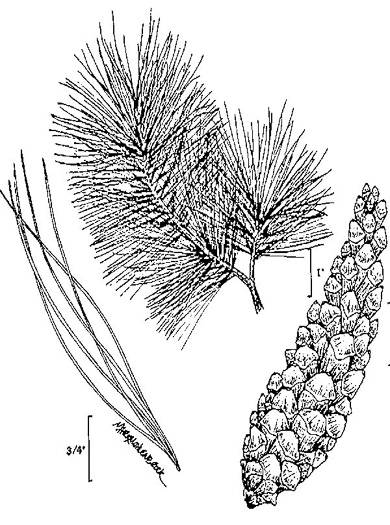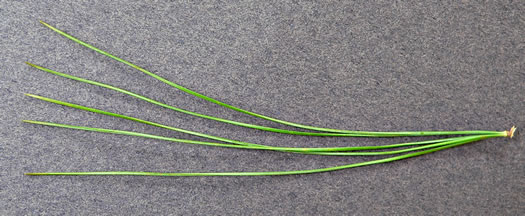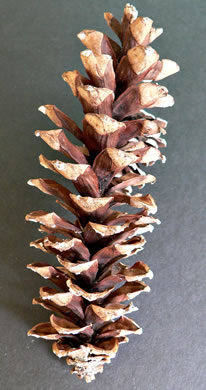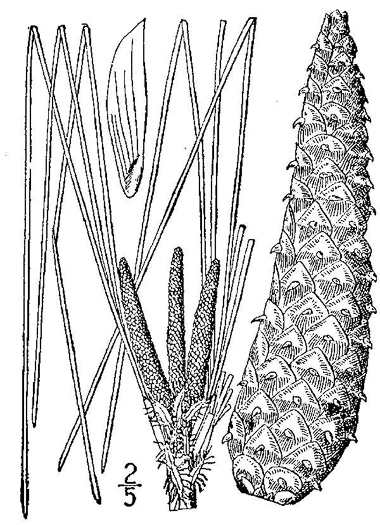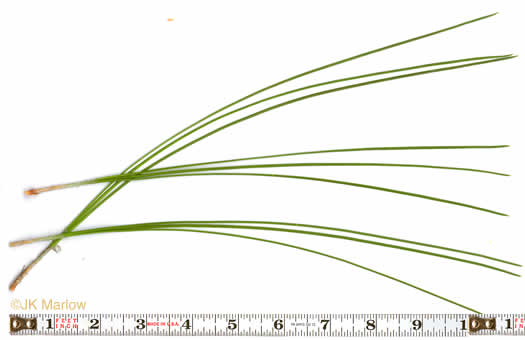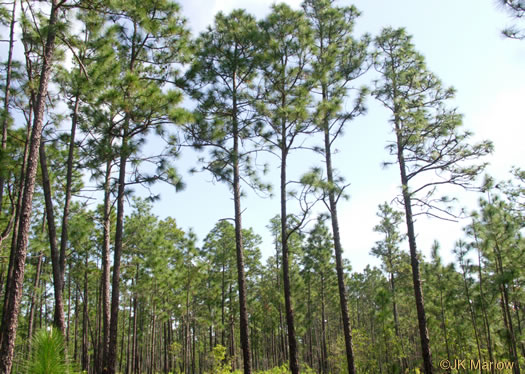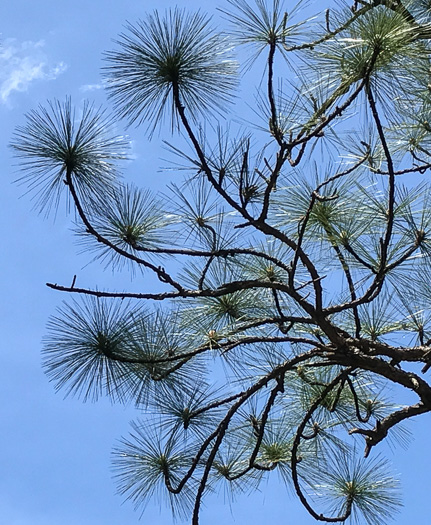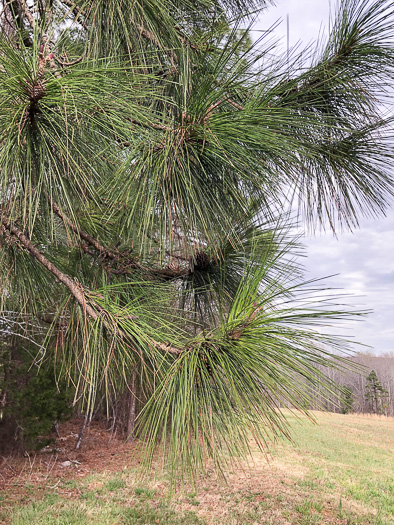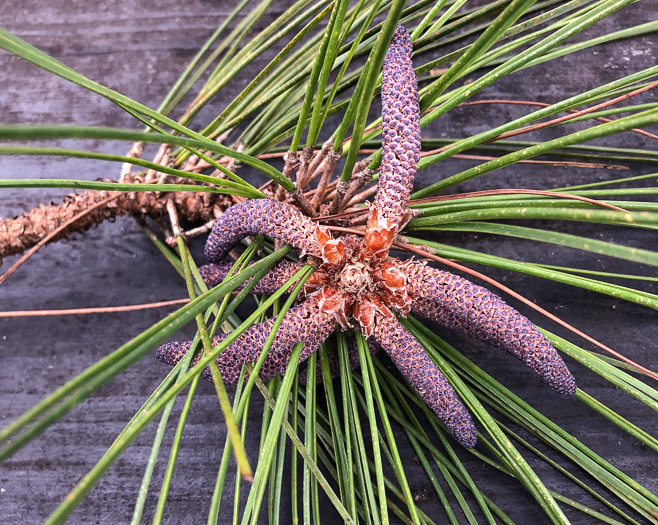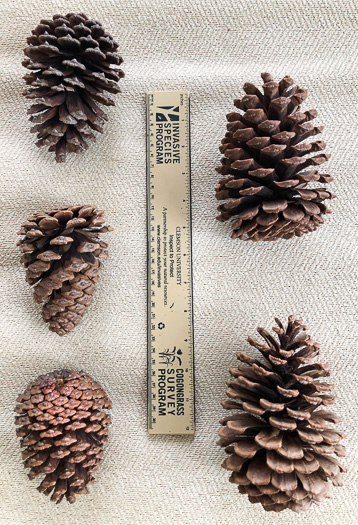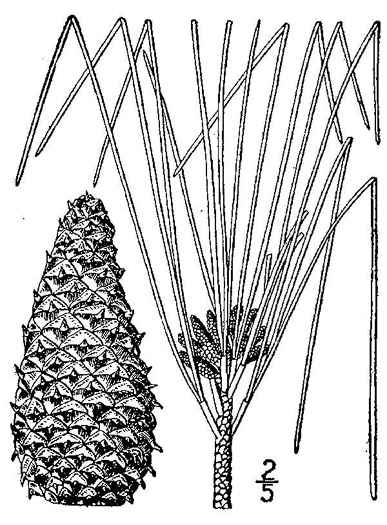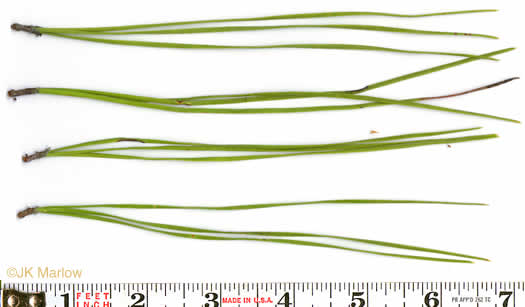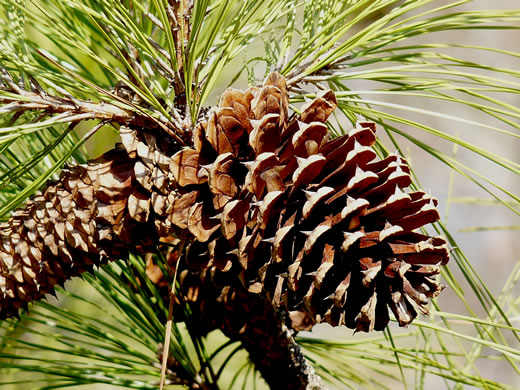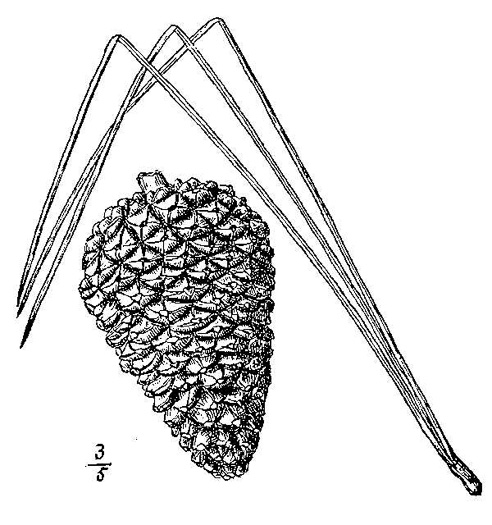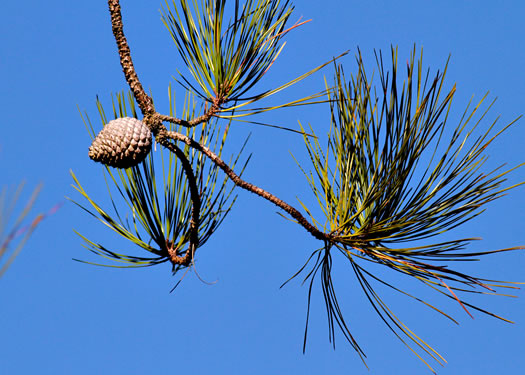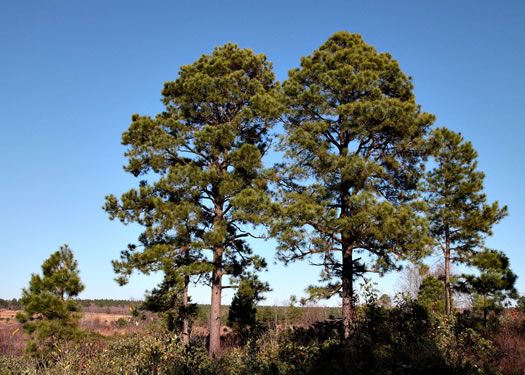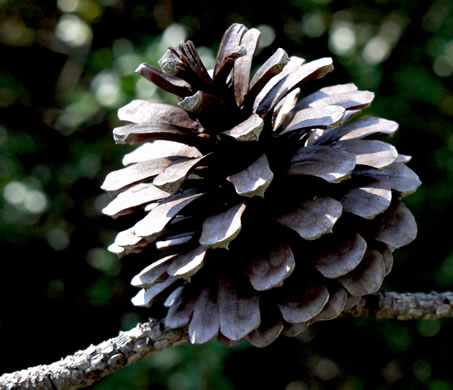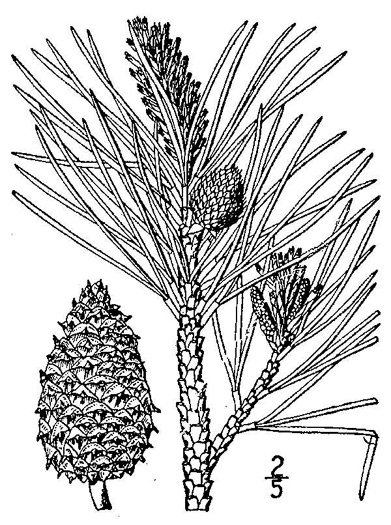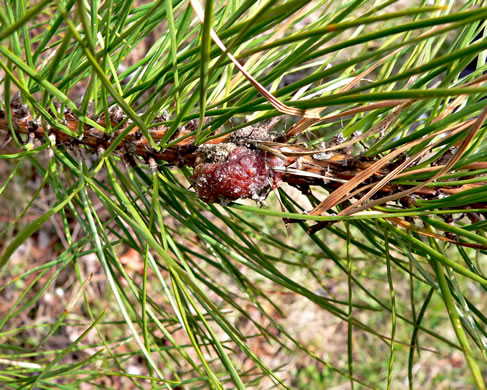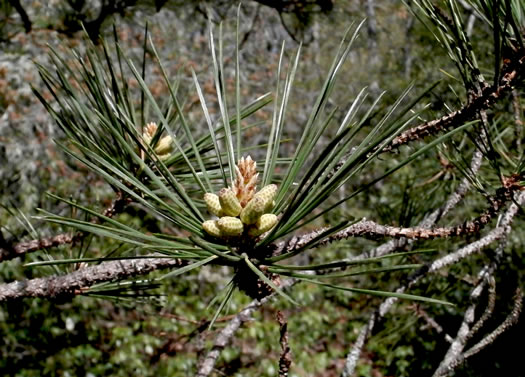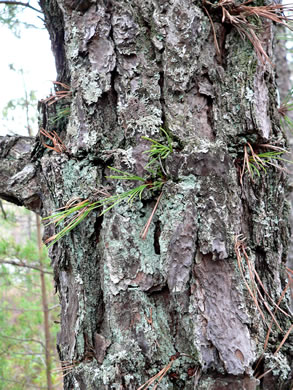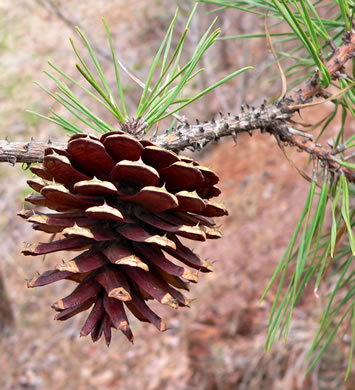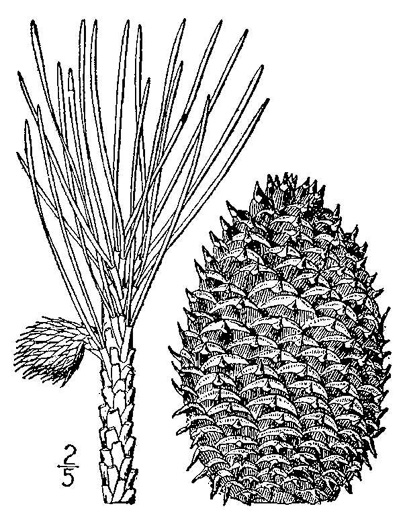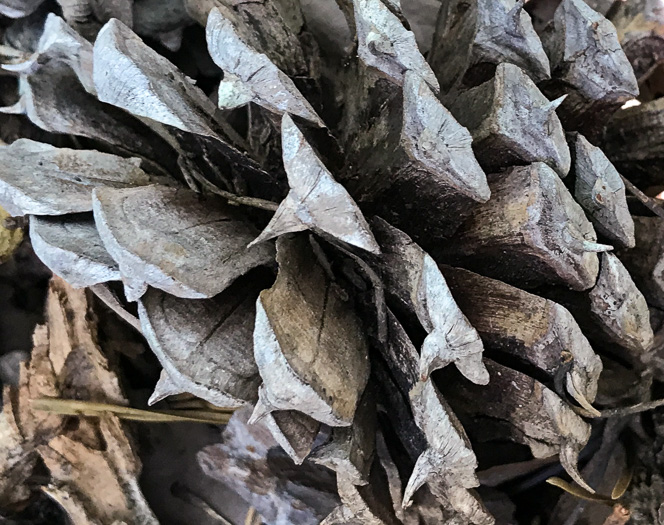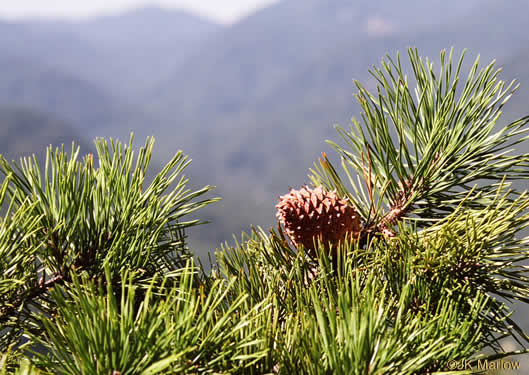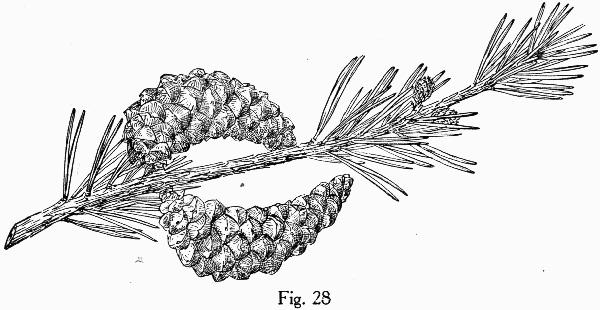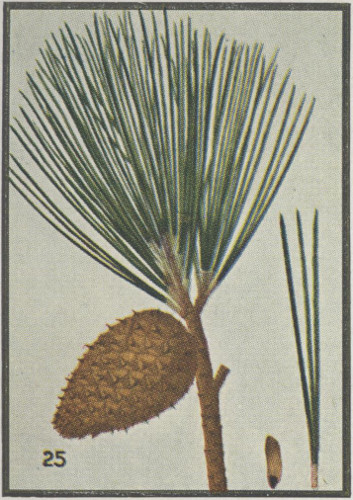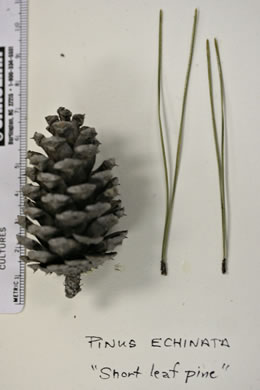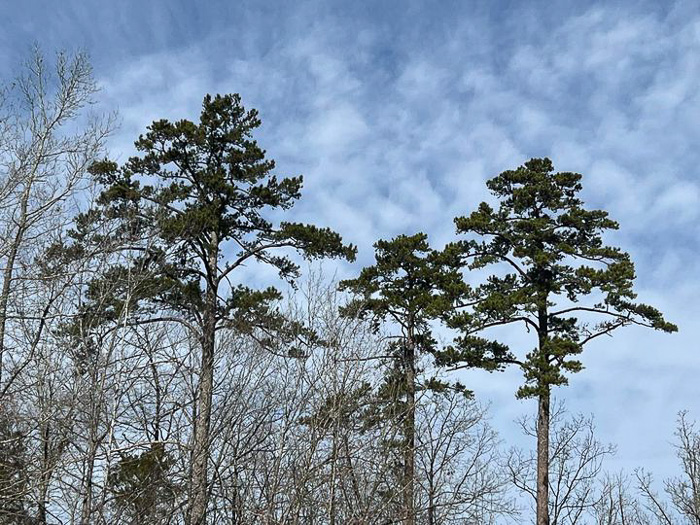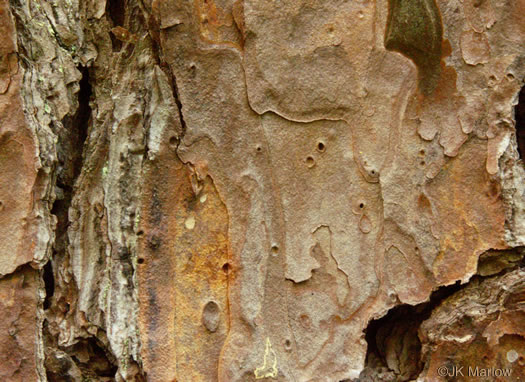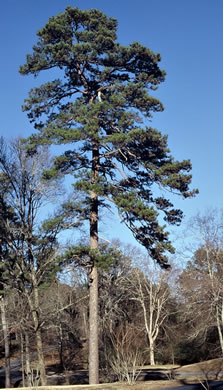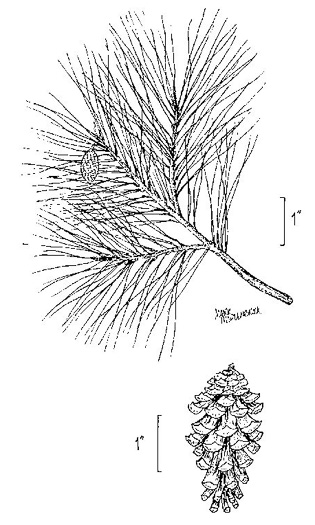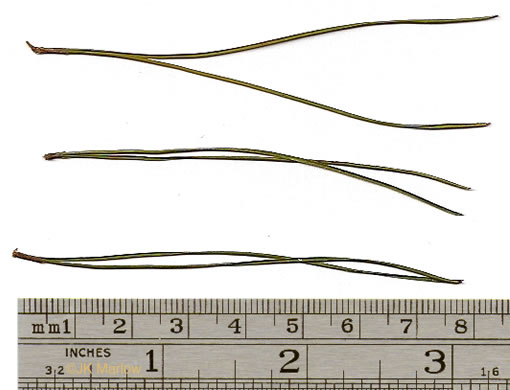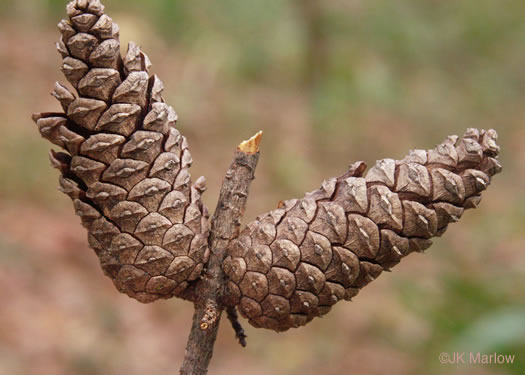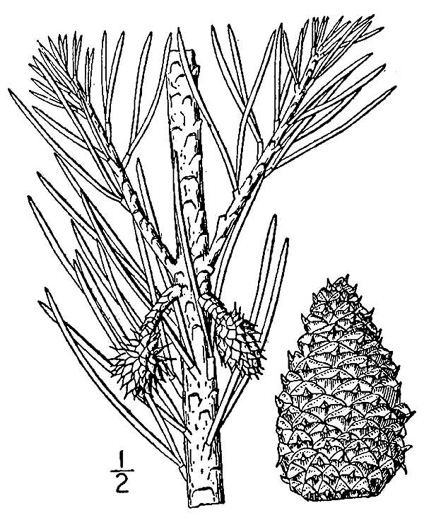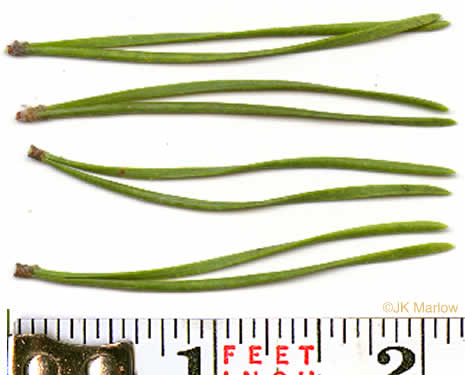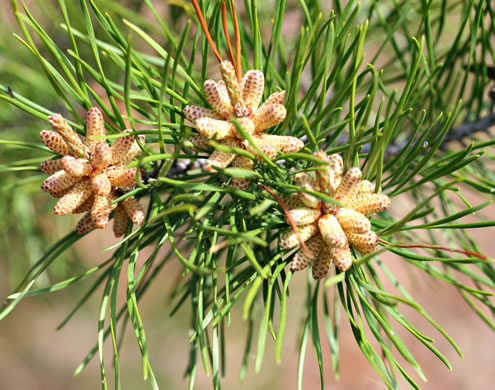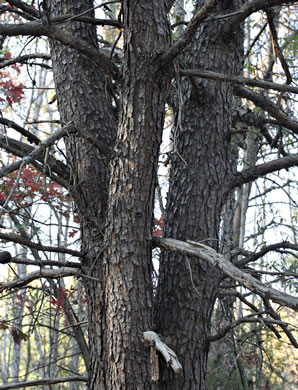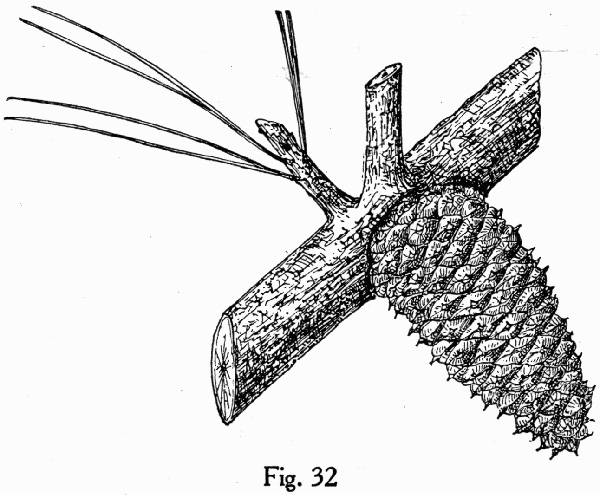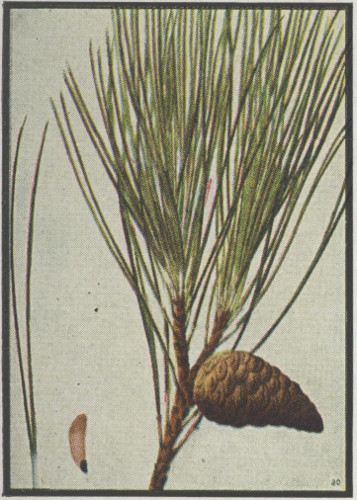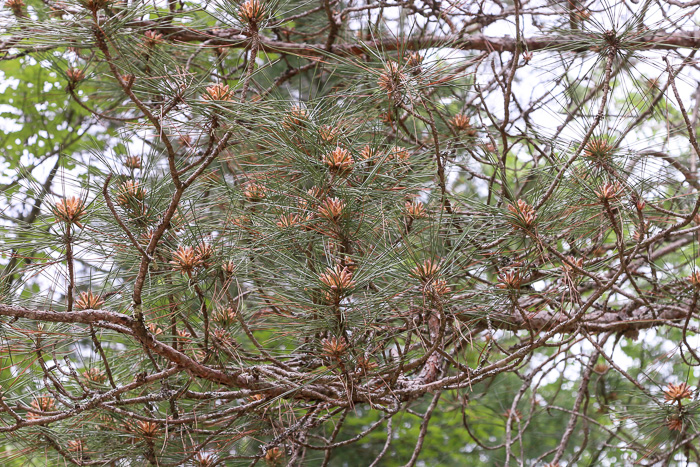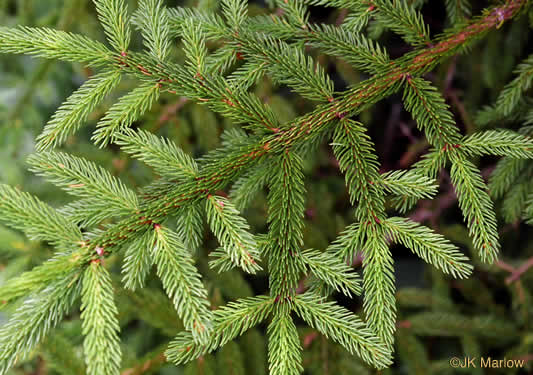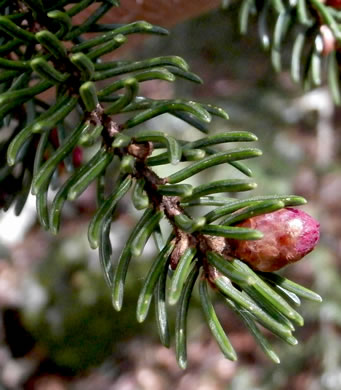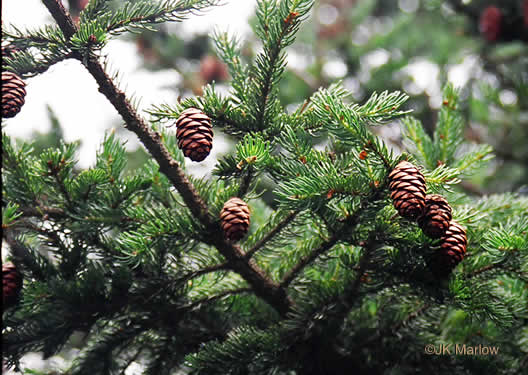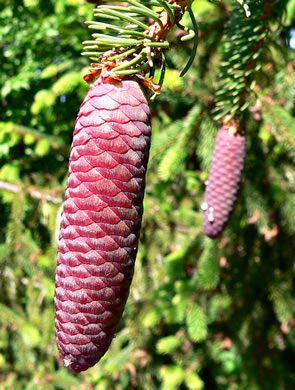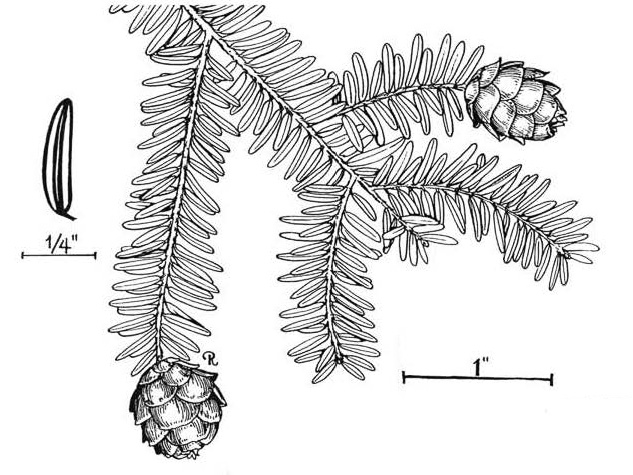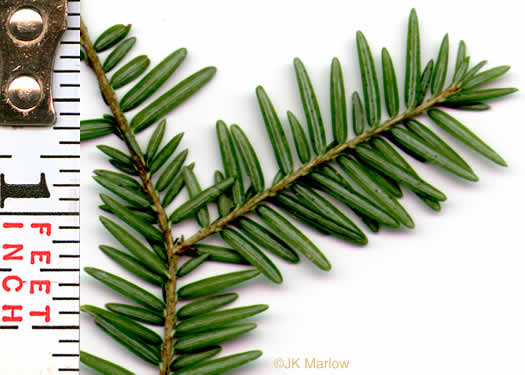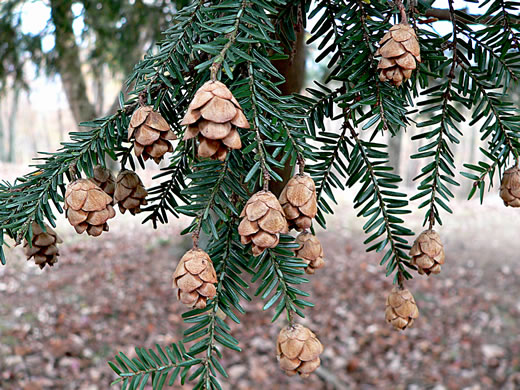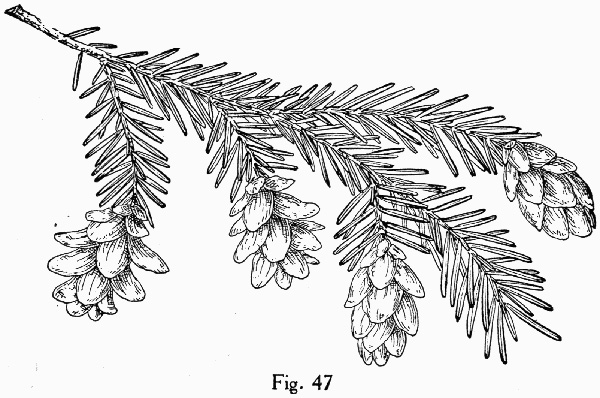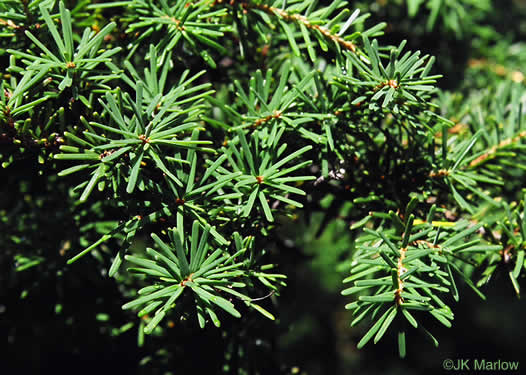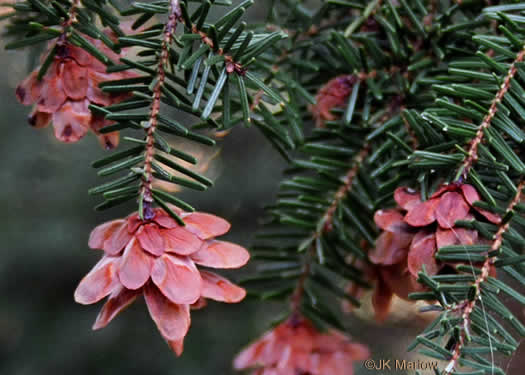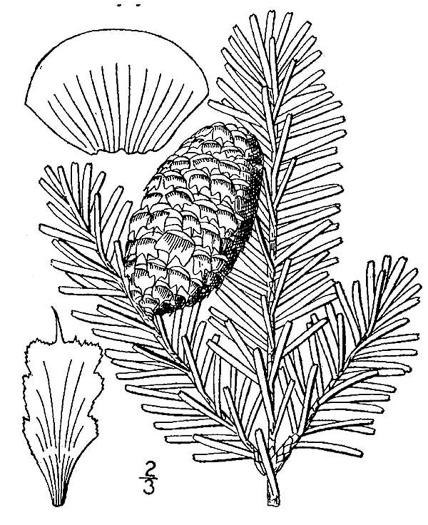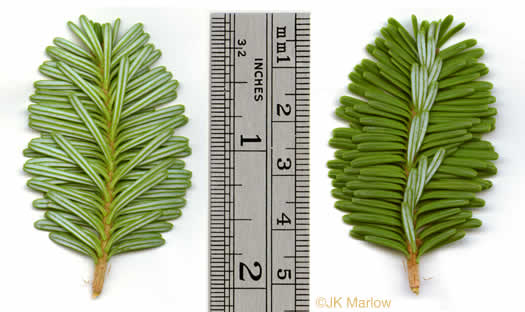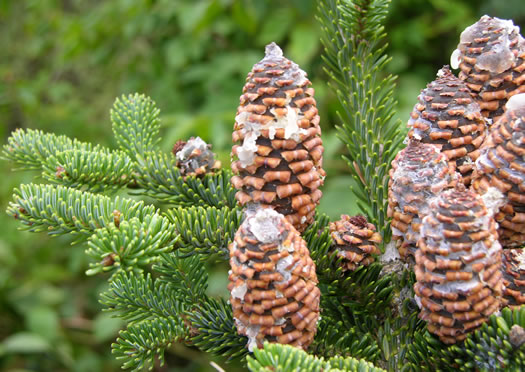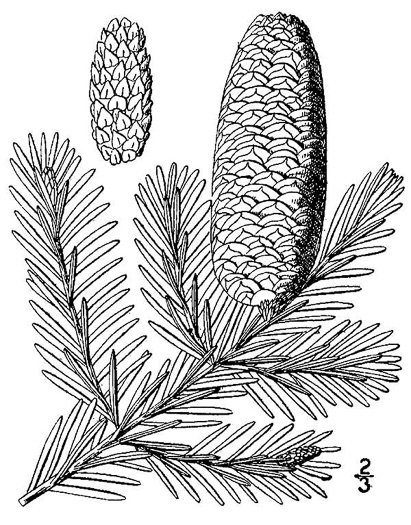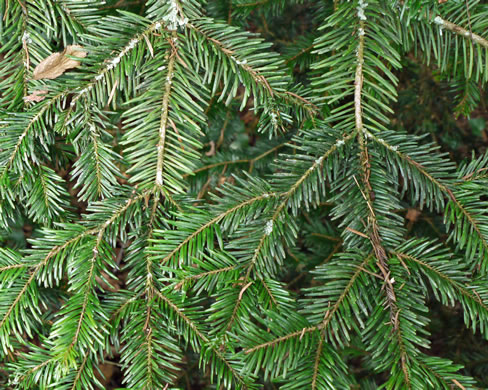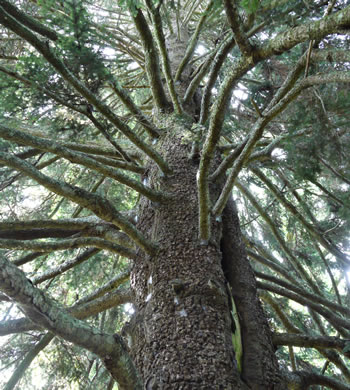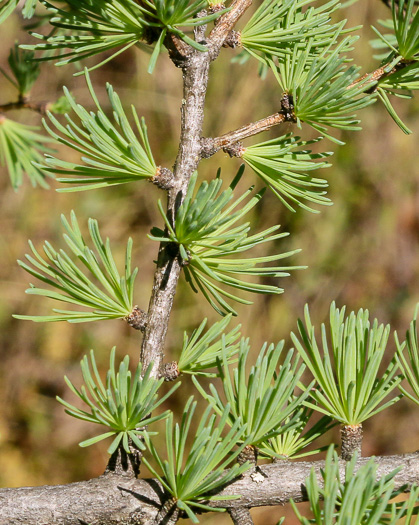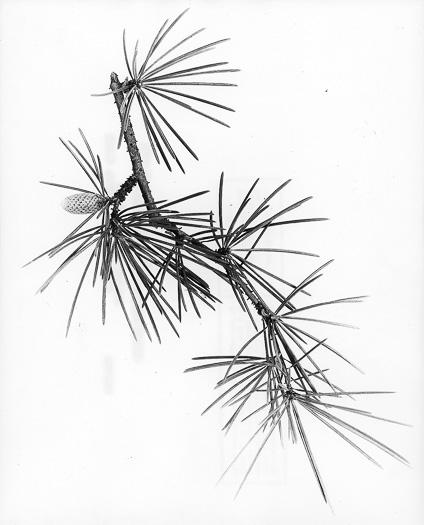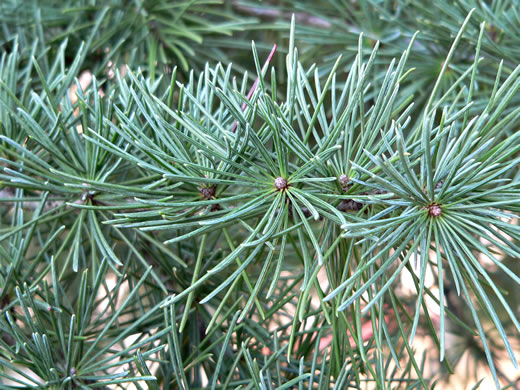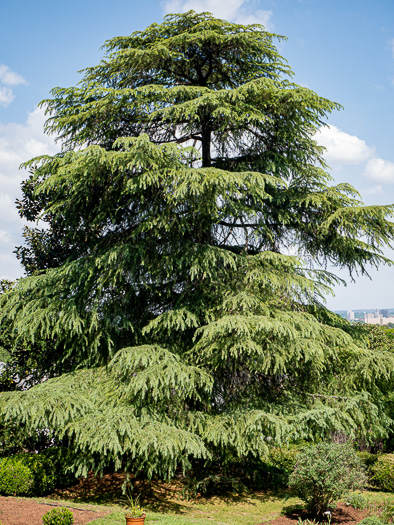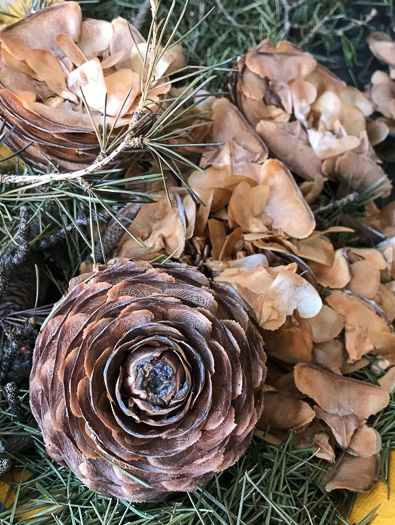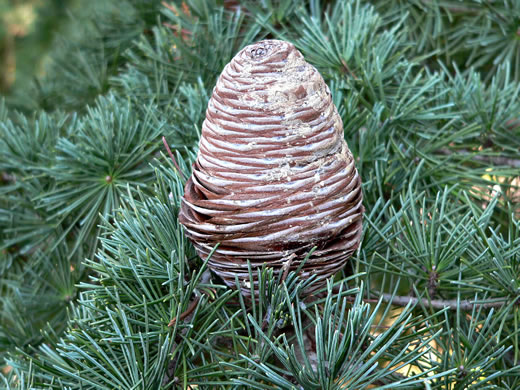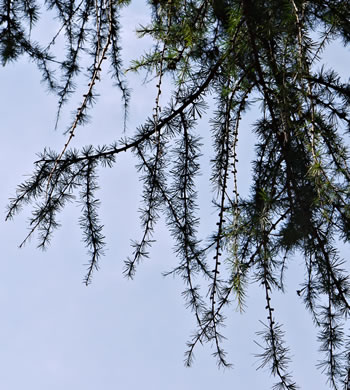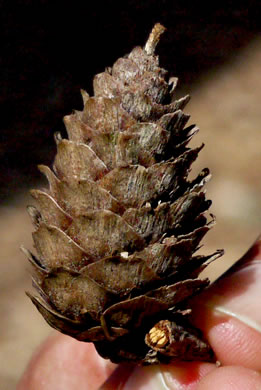Hovering over an image will enlarge it and point out features (works better on desktop than on mobile).
![]() A camera indicates there are pictures.
A camera indicates there are pictures.
![]() A speaker indicates that a botanical name is pronounced.
A speaker indicates that a botanical name is pronounced.
![]() A plus sign after a Latin name indicates that the species is further divided into varieties or subspecies.
A plus sign after a Latin name indicates that the species is further divided into varieties or subspecies.
Most habitat and range descriptions were obtained from Weakley's Flora.
Your search found 26 taxa in the family Pinaceae, Pine family, as understood by Weakley's Flora.

![]()
![]() Common Name:
Eastern White Pine
Common Name:
Eastern White Pine
Weakley's Flora: (4/24/22) Pinus strobus FAMILY: Pinaceae
SYNONYMOUS WITH PLANTS National Database: Pinus strobus FAMILY: Pinaceae
SYNONYMOUS WITH Vascular Flora of the Carolinas (Radford, Ahles, & Bell, 1968): Pinus strobus 016-01-001 FAMILY: Pinaceae
Habitat: Moist to dry forests, bottomlands, dry, rocky ridges in humid gorges, also planted in timber plantations
Common (waifs in Coastal Plain)
Native to the Mountains & Piedmont of the Carolinas & Georgia

![]()
![]() Common Name:
Longleaf Pine, Southern Pine
Common Name:
Longleaf Pine, Southern Pine
Weakley's Flora: (4/24/22) Pinus palustris FAMILY: Pinaceae
SYNONYMOUS WITH PLANTS National Database: Pinus palustris FAMILY: Pinaceae
SYNONYMOUS WITH Vascular Flora of the Carolinas (Radford, Ahles, & Bell, 1968): Pinus palustris 016-01-002 FAMILY: Pinaceae
Habitat: Formerly throughout the Coastal Plain, Sandhills, and lower Piedmont, on a wide variety of soils (sandy, loamy, clayey, or peaty), from very dry to very wet conditions, in pine savannas, pine woodlands, and pine forests affected by relatively frequent natural (lightning caused) fires (likely augmented by native Americans), now reduced to an estimated 3% of its former abundance by a variety of forces, including turpentining, timbering, free-range hogs, fire suppression, and ‘site conversion’ by foresters to other trees, now extremely rare in VA and north of the Neuse River in NC, still occurring in some abundance in the outer Coastal Plain from Carteret County, NC south into GA, in the Bladen Lakes area of Bladen and Cumberland counties, and in the Fall-Line Sandhills of Harnett, Hoke, Scotland, Richmond, Moore, Anson, and Montgomery counties, NC and south into GA. Further southward into peninsular FL, this species is more exclusive to sandhill and flatwood habitats, replaced in wetter sites by Pinus elliottii and P. densa and more xeric sites by P. clausa
Common in Coastal Plain, uncommon in GA Piedmont, rare in elsewhere in GA-NC-SC
Native to the Carolinas & Georgia

![]()
![]() Common Name:
Slash Pine
Common Name:
Slash Pine
Weakley's Flora: (4/24/22) Pinus elliottii FAMILY: Pinaceae
SYNONYMOUS WITH PLANTS National Database: Pinus elliottii var. elliottii FAMILY: Pinaceae
INCLUDED WITHIN Vascular Flora of the Carolinas (Radford, Ahles, & Bell, 1968): Pinus elliottii 016-01-003 FAMILY: Pinaceae
Habitat: Native in wet pine flatwoods and maritime forests, also extensively planted (over a broader distribution than the natural one, as in GA, SC, NC, w. LA, e. TX) in silvicultural plantations on a wide variety of soils, many of them unsuitable for its successful growth
Common
Native to South Carolina & Georgia

![]()
![]() Common Name:
Loblolly Pine, Old Field Pine
Common Name:
Loblolly Pine, Old Field Pine
Weakley's Flora: (4/24/22) Pinus taeda FAMILY: Pinaceae
SYNONYMOUS WITH PLANTS National Database: Pinus taeda FAMILY: Pinaceae
SYNONYMOUS WITH Vascular Flora of the Carolinas (Radford, Ahles, & Bell, 1968): Pinus taeda 016-01-004 FAMILY: Pinaceae
Habitat: Dry to dry-mesic upland forests and woodlands, riparian forests, maritime forests, sandy rises in bottomland forests, pine flatwoods, roadsides, pine plantations, disturbed areas, especially in acid soil, much more abundant and widespread than formerly, and occurring farther inland than as a native
Common (rare in Mountains)
Native to the Carolinas & Georgia

![]()
![]() Common Name:
Pond Pine, Pocosin Pine, Marsh Pine
Common Name:
Pond Pine, Pocosin Pine, Marsh Pine
Weakley's Flora: (4/24/22) Pinus serotina FAMILY: Pinaceae
SYNONYMOUS WITH PLANTS National Database: Pinus serotina FAMILY: Pinaceae
SYNONYMOUS WITH Vascular Flora of the Carolinas (Radford, Ahles, & Bell, 1968): Pinus serotina 016-01-005 FAMILY: Pinaceae
Habitat: Peaty soils of pocosins, swamps of small blackwater streams, sometimes a component of very wet pine savannas over an herbaceous groundlayer, but usually associated with dense pocosin shrubs
Common (rare in Piedmont)
Native to the Carolinas & Georgia

![]()
![]() Common Name:
Pitch Pine
Common Name:
Pitch Pine
Weakley's Flora: (4/24/22) Pinus rigida FAMILY: Pinaceae
SYNONYMOUS WITH PLANTS National Database: Pinus rigida FAMILY: Pinaceae
SYNONYMOUS WITH Vascular Flora of the Carolinas (Radford, Ahles, & Bell, 1968): Pinus rigida 016-01-006 FAMILY: Pinaceae
Habitat: Southward primarily on dry ridges, more or less requiring fire for its reproduction, less commonly in peat soils of mountain bogs (and then often at elevations of 800-1000 m), northward (as in NJ) in acidic sandy and peaty soils near sea level, and also scattered through a variety of forest types. It is abundant near sea level in the Pine Barrens of NJ, but in NC is limited to the mountains and upper Piedmont; it is replaced in Coastal Plain fire-maintained wetland communities by the related Pinus serotina
Common in NC Mountains, uncommon in GA & SC Mountains & NC Piedmont (rare elsewhere in GA-NC-SC)
Native to the Carolinas & Georgia

![]()
![]() Common Name:
Table Mountain Pine, Bur Pine, Hickory Pine, Prickly Pine
Common Name:
Table Mountain Pine, Bur Pine, Hickory Pine, Prickly Pine
Weakley's Flora: (4/24/22) Pinus pungens FAMILY: Pinaceae
SYNONYMOUS WITH PLANTS National Database: Pinus pungens FAMILY: Pinaceae
SYNONYMOUS WITH Vascular Flora of the Carolinas (Radford, Ahles, & Bell, 1968): Pinus pungens 016-01-007 FAMILY: Pinaceae
Habitat: Dry ridges, cliffs, shale barrens, usually requiring fire for its reproduction, occurring at least up to 1550 m
Common (rare in Piedmont)
Native to the Carolinas & Georgia

Common Name: Jack Pine
Weakley's Flora: (2/10/25) Pinus banksiana FAMILY: Pinaceae
SYNONYMOUS WITH PLANTS National Database: Pinus banksiana FAMILY: Pinaceae
Habitat: Dry forests
Native: northern New England, throughout Canada

Common Name: Austrian Pine
Weakley's Flora: (2/10/25) Pinus nigra ssp. nigra FAMILY: Pinaceae
INCLUDED WITHIN PLANTS National Database: Pinus nigra FAMILY: Pinaceae
Habitat: Disturbed areas
Waif(s)
Non-native: Europe

Common Name: Scots Pine
Weakley's Flora: (2/10/25) Pinus sylvestris var. sylvestris FAMILY: Pinaceae
INCLUDED WITHIN PLANTS National Database: Pinus sylvestris FAMILY: Pinaceae
Habitat: Cultivated and sometimes escaped or long persistent in settings where not obviously planted
Waif(s)
Non-native: Europe

![]()
![]() Common Name:
Shortleaf Pine, Yellow Pine, Rosemary Pine
Common Name:
Shortleaf Pine, Yellow Pine, Rosemary Pine
Weakley's Flora: (4/14/23) Pinus echinata FAMILY: Pinaceae
SYNONYMOUS WITH PLANTS National Database: Pinus echinata FAMILY: Pinaceae
SYNONYMOUS WITH Vascular Flora of the Carolinas (Radford, Ahles, & Bell, 1968): Pinus echinata 016-01-008 FAMILY: Pinaceae
Habitat: Dry to dry-mesic upland forests and woodlands, rocky ridges and slopes, glades, bluffs, Coastal Plain sandhills, old fields, riparian forests, generally in rather xeric sites and on acid soils, but also occurring in mesic to even wet sites and on mafic or subcalcareous rocks
Common
Native to the Carolinas & Georgia

![]()
![]() Common Name:
Spruce Pine, Walter's Pine
Common Name:
Spruce Pine, Walter's Pine
Weakley's Flora: (4/24/22) Pinus glabra FAMILY: Pinaceae
SYNONYMOUS WITH PLANTS National Database: Pinus glabra FAMILY: Pinaceae
SYNONYMOUS WITH Vascular Flora of the Carolinas (Radford, Ahles, & Bell, 1968): Pinus glabra 016-01-009 FAMILY: Pinaceae
Habitat: Bottomland forests, rich, moist soils, also upland in calcareous areas, such as calcareous bluffs. This pine is unusual in growing in moist (even infrequently flooded), fertile habitats, usually mixed with bottomland hardwoods, and rather shade tolerant, sometimes growing as an understory tree
Common in GA, rare in SC
Native to South Carolina & Georgia

![]()
![]() Common Name:
Virginia Pine, Scrub Pine, Jersey Pine, Possum Pine
Common Name:
Virginia Pine, Scrub Pine, Jersey Pine, Possum Pine
Weakley's Flora: (4/14/23) Pinus virginiana FAMILY: Pinaceae
SYNONYMOUS WITH PLANTS National Database: Pinus virginiana FAMILY: Pinaceae
SYNONYMOUS WITH Vascular Flora of the Carolinas (Radford, Ahles, & Bell, 1968): Pinus virginiana 016-01-010 FAMILY: Pinaceae
Habitat: Dry forests and woodlands, especially on slopes and ridges, also common in certain areas as a weedy successional tree on nearly any kind of site, such as rocky, sandy, or clayey successional old fields or blowdowns
Common (rare in Coastal Plain)
Native to the Carolinas & Georgia

![]() Common Name:
Sand Pine
Common Name:
Sand Pine
Weakley's Flora: (4/14/23) Pinus clausa FAMILY: Pinaceae
SYNONYMOUS WITH PLANTS National Database: Pinus clausa FAMILY: Pinaceae
Habitat: Florida scrub, and dry sands where planted outside of its native range, for instance widely planted in pulp plantations in FL and s. GA, experimentally planted as far north as NC (and persisting and naturalizing)
Uncommon in GA Coastal Plain, rare in Carolinas
Native: Florida

![]()
![]() Common Name:
Red Pine
Common Name:
Red Pine
Weakley's Flora: (4/14/23) Pinus resinosa FAMILY: Pinaceae
SYNONYMOUS WITH PLANTS National Database: Pinus resinosa FAMILY: Pinaceae
Habitat: High elevation forests, in pine plantations, and persisting after silvicultural plantings. Further north often growing on dry, rocky (south-facing) ridges and bluffs
Waif(s)
Native: north of the Carolinas & Georgia

![]()
![]() Common Name:
Red Spruce, He Balsam
Common Name:
Red Spruce, He Balsam
Weakley's Flora: (4/24/22) Picea rubens FAMILY: Pinaceae
SYNONYMOUS WITH PLANTS National Database: Picea rubens FAMILY: Pinaceae
SYNONYMOUS WITH Vascular Flora of the Carolinas (Radford, Ahles, & Bell, 1968): Picea rubens 016-02-001 FAMILY: Pinaceae
Habitat: Common to dominant in spruce and spruce-fir forests at high elevations, scattered in northern hardwood forests, heath balds, boulderfield forests, ridges, and rarely coves, also in bogs or swampy forests at lower elevations (in NC not below 1000 m), ranging in moisture tolerance from dry ridges (though these are often fog-bathed) to saturated peats, and sometimes planted and naturalized. Picea rubens appears as scattered individuals ("natural waifs") at lower elevations than it is usually found; these seem to reflect sporadic seeding and short term survival and growth from some natural means
Uncommon in NC Mountains, rare or waifs elsewhere in GA-NC-SC
Native to the Carolinas & Georgia

![]()
![]() Common Name:
Norway Spruce
Common Name:
Norway Spruce
Weakley's Flora: (4/24/22) Picea abies FAMILY: Pinaceae
SYNONYMOUS WITH PLANTS National Database: Picea abies FAMILY: Pinaceae
Habitat: Fairly commonly planted in the montane and northern parts of our area as a street or yard tree, also persisting and escaping from forestry plantations at moderate or high elevations, notably in e. WV, Great Smoky Mountains National Park (Kephart Prong), Mount Mitchell State Park, and the Biltmore Estate
Waif(s)
Non-native: northern Europe

![]()
![]() Common Name:
Eastern Hemlock, Canada Hemlock, Spruce Pine, Hemlock Spruce
Common Name:
Eastern Hemlock, Canada Hemlock, Spruce Pine, Hemlock Spruce
Weakley's Flora: (4/14/23) Tsuga canadensis FAMILY: Pinaceae
SYNONYMOUS WITH PLANTS National Database: Tsuga canadensis FAMILY: Pinaceae
SYNONYMOUS WITH Vascular Flora of the Carolinas (Radford, Ahles, & Bell, 1968): Tsuga canadensis 016-03-001 FAMILY: Pinaceae
Habitat: In a wide variety of habitats in the mountains, most typically and abundantly in moist sites in ravines or coves along streams, but likely to be found in all but the driest habitats between 300 and 1500 m (even occurring in peaty bogs, where it has a sickly yellow color and short life expectancy); in the western Piedmont of NC limited to progressively rarer microhabitats (primarily north-facing river bluffs), reaching its eastward limit in NC at a disjunct stand at Hemlock Bluff State Natural Area, Wake County (but uncommon in the Piedmont of VA and even present, though rare, in the Coastal Plain of VA)
Common in Mountains, rare in Piedmont
Native to the Carolinas & Georgia

![]()
![]() Common Name:
Carolina Hemlock, Crag Hemlock
Common Name:
Carolina Hemlock, Crag Hemlock
Weakley's Flora: (4/14/23) Tsuga caroliniana FAMILY: Pinaceae
SYNONYMOUS WITH PLANTS National Database: Tsuga caroliniana FAMILY: Pinaceae
SYNONYMOUS WITH Vascular Flora of the Carolinas (Radford, Ahles, & Bell, 1968): Tsuga caroliniana 016-03-002 FAMILY: Pinaceae
Habitat: Primarily in open forests on ridge tops, rocky bluffs, or gorge walls, generally in drier and rockier sites than T. canadensis, but the two sometimes growing in close proximity or even intermixed in humid gorges; very limited in the western Piedmont, apparently reaching its eastern limit in NC at Hanging Rock State Park, Stokes County, and ranging east to Halifax County in the Piedmont of VA
Uncommon in NC Mountains (rare elsewhere in GA-NC-SC)
Native to the Carolinas & Georgia

![]()
![]() Common Name:
Fraser Fir, She Balsam, Southern Balsam
Common Name:
Fraser Fir, She Balsam, Southern Balsam
Weakley's Flora: (4/24/22) Abies fraseri FAMILY: Pinaceae
SYNONYMOUS WITH PLANTS National Database: Abies fraseri FAMILY: Pinaceae
SYNONYMOUS WITH Vascular Flora of the Carolinas (Radford, Ahles, & Bell, 1968): Abies fraseri 016-04-001 FAMILY: Pinaceae
Habitat: High elevation forests, from about 1500-2037 m
Rare in NC Mountains (waifs in GA)
Native to North Carolina, naturalized in Georgia

![]() Common Name:
Balsam Fir, Northern Balsam, Canada Balsam, Blister Pine
Common Name:
Balsam Fir, Northern Balsam, Canada Balsam, Blister Pine
Weakley's Flora: (4/24/22) Abies balsamea FAMILY: Pinaceae
SYNONYMOUS WITH PLANTS National Database: Abies balsamea FAMILY: Pinaceae
Habitat: High elevation forests and cliffs (in VA and northwards); high elevation frost-pocket wetlands (WV), northwards somewhat more general in cool, mountain areas
Native: north of the Carolinas

Common Name: European Fir, Silver Fir
Weakley's Flora: (4/14/23) Abies alba FAMILY: Pinaceae
SYNONYMOUS WITH PLANTS National Database: Abies alba FAMILY: Pinaceae
Habitat: Naturalized in Highlands, NC (Macon Co.), from plantings made by Thomas G. Harbison in the late 1800's (J.D. Pittillo, pers. comm.)
Waif(s)
Non-native: Europe

![]() Common Name:
Eastern Tamarack, Eastern Larch
Common Name:
Eastern Tamarack, Eastern Larch
Weakley's Flora: (4/24/22) Larix laricina FAMILY: Pinaceae
SYNONYMOUS WITH PLANTS National Database: Larix laricina FAMILY: Pinaceae
Habitat: Bogs and swamps
Rare
Native: north of the Carolinas

![]()
![]() Common Name:
Deodar Cedar
Common Name:
Deodar Cedar
Weakley's Flora: (4/14/23) Cedrus deodara FAMILY: Pinaceae
SYNONYMOUS WITH PLANTS National Database: Cedrus deodara FAMILY: Pinaceae
Habitat: Frequently planted, rarely persistent or possibly escaped to suburban woodlands
Waif(s)
Non-native: Himalayan Asia

![]() Common Name:
European Larch
Common Name:
European Larch
Weakley's Flora: (4/14/23) Larix decidua FAMILY: Pinaceae
SYNONYMOUS WITH PLANTS National Database: Larix decidua FAMILY: Pinaceae
Habitat: Forests
Waif(s)
Non-native: Europe
Your search found 26 taxa. You are on page PAGE 1 out of 1 pages.

